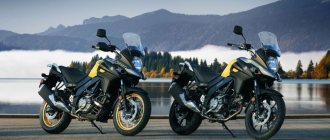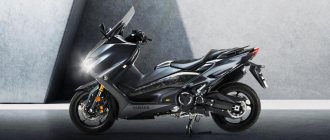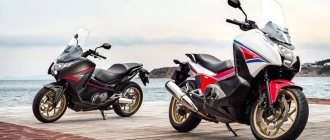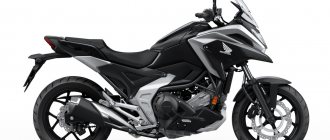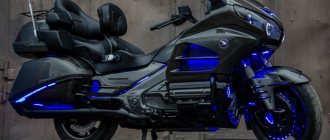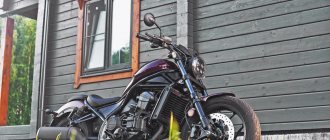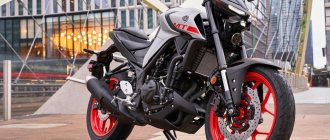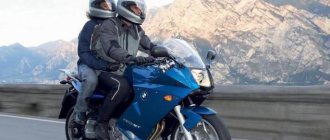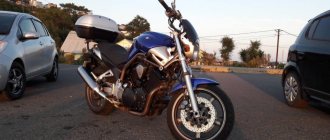Review of the Yamaha V-max 1200 motorcycle
I liked the motorcycle - it’s a very charismatic car, but I wouldn’t recommend it for a big city. It eats a lot, weighs a lot, drives great, but steers and brakes very mediocre. That is, it, of course, steers and brakes, but extremely sadly. At least without stretch marks and in stock. Changing to the 954th Fire, I was childishly happy about its brakes, and returning to the saddle of mine, I felt despondent)). Roughly speaking, the engine and chassis are very conditionally suitable for each other. Although for the 80s, where he comes from, of course, everything is normal.
Personally, I was tired of struggling with hardware on a daily basis, and decided to sell my faithful friend. The bike sold out at the end of the season for more than it was purchased for, and quite quickly.
I’m sure many will find a lot of positive aspects in the V-MAXe, but personally, I discovered enduro for myself, so now I look with disdain at heavy iron monsters on the additional stage.
I haven't owned the motor for long. Before that there were sports and sports tourists. The predecessor is the thrush. To be honest, I always wanted to touch and ride this motorcycle and, as they say, childhood dreams come true.
This spendthrift (probably like any other) has its own problems/shortcomings, so I’ll probably start with the cons.
1) Very inconvenient for long distances. In any case, I begin to fidget on it after 300 km. I want to get up and change the position of the 5th point. In general, this is caused by an extremely hard, uncomfortable seat. In principle, it can be treated in any studio.
2) Brakes. Some say they exist, some say they don’t. In general, my driving style has already become moderate; I don’t drive (except on open straights when there is no one around). Despite all this, there really aren’t enough of them. Even in the city. Even in traffic jams. If you are careless, you can simply overpress and block the wheel. Replacing calipers (from P1), brake hoses, discs, pads will not achieve the expected effect. This is such a motorcycle.
3) Tank. It's small. With my daily mileage of about 60 km, I fill up once every 2 days (although the light does not light up, which means there are more than 3 liters left in the tank). At the v-max club there seem to be boiled tanks, but judging by the price tag, the kulibins there were simply drunk. Do you want to fill up twice as often? No problem. Half the cost of the moto is in good condition and you are the owner of a boiled tank.
4) Overtaking. Headache. I treated myself. I ordered a new one, installed stronger bolts and placed them on a thread locker + grommets. 3000 km flight is normal.
5) Cardan end cap. It burst on me on the way to work. I arrived home in grief. As it turned out, this is also a sore. I treated it like this: I drilled out the tripe with a broken piece (on the gear in the differential). I cut a thread inside and screwed a hardened pin into the thread lock. The nut on this stud needs to be tightened to 110nm. It's very hard. I stopped the gear directly in the gearbox and twisted it gradually increasing the torque (from 40 nm - twisted to 114) it will be difficult. When disassembling, you will need a special wrench that can be used to unscrew the bushing from the housing and release the main pair with the bearing.
6) Weak fork. It's clearly not for this motorcycle. I feel that the seals will have to be changed quite often.
7) Weak battery (in capacity), weak generator. You will have to check the condition of the battery often, otherwise the 1.2-liter “fool” may not turn over one day. If you decide to hang up “blackjack” and you know what, the generator won’t allow it.
 Coils \ spark plug caps. They are flooded. The caps tend to melt. It is treated by installing “COP” coils in the caps. After washing, the engine will start 100% (if there are no other faults). Suitable for Eroks, Jixers and Firebloods.
Coils \ spark plug caps. They are flooded. The caps tend to melt. It is treated by installing “COP” coils in the caps. After washing, the engine will start 100% (if there are no other faults). Suitable for Eroks, Jixers and Firebloods.
In terms of shortcomings, that's all.
Pros:
1) Acceleration dynamics. It's really like high-power sports. I don’t know how to modify it (I have 2WE), but the motor starts confidently.
2) Handling even at the lowest speeds is excellent. Once you get going, weight no longer matters.
3) Maintainability. The motorcycle can be repaired “on the knee”. Everything is clear, convenient and not difficult to access.
4) Availability of spare parts. A sea of tuning. There is room to put your hands to work.
5) Design that is relevant to this day. People are constantly staring. Everywhere it is classified into different classes. Dregster, cafe racer, muscle bike, cruiser, road bike...
6) Even in case of serious breakdowns, you will always get to the place of repair.
7) It’s comfortable for rope rope riders to sit.
 Low price of a motorcycle.
Low price of a motorcycle.
In general, I have extremely positive impressions from the moto, although I expected otherwise. There are more rumors than truth about him. I got used to it within the first 10 minutes of the trip, but you need to understand what kind of car is underneath you.
Yes, it’s heavy (but I’m not small either, 190 height, 90 kg weight), but due to the fact that its tank is under the seat, the center of gravity is low, and it only starts to fall over when it’s almost stopped (and then you can hold the balance with your body). The stock frame lacks rigidity, but fortunately there is enough tuning and this problem can be solved. The vertical seating position and straight steering wheel, combined with a comfortable seat, provide maximum comfort. The only problem is the wind protection, after 120 it blows away, but again tuning saves the day.
The most interesting thing is the engine, it is powerful and flexible, allowing you to ride both in a chopper style and almost in a sport bike style. Whether you’re traveling with two or alone, he doesn’t care, it’s rushing like a tank, it doesn’t make any difference, I can’t say anything about the sound.
The only downside I can name is that the clutch is very tight (maybe it’s just me) and it’s problematic to turn into a corner at speed, you’ll screw it up. In general, I’m very pleased so far, I don’t see anything more worthy for the money.
Having sold my GSXR 1100, I was looking for a device with a direct fit. Thanks to the one who suggested buying VMAX. After the sale, I spent days and nights on the forums, reading about everything. Now it’s my turn, and I read owner reviews about Yamaha V Max. Motz is truly impressive - real, powerful, low-slung and of excellent Japanese build quality! At first I was worried whether I could cope with it, but trouble began. Since I got it in a worn condition, I started cleaning it. Having removed the tank, I removed all the rust, and there was plenty of it. The engine and carbs were surprisingly fine. The mileage was more than ten, the condition spoke about it. Of course, I immediately changed the oils and filters, since I planned to drive every day, and not once a month. I drive both around the city and at night on the highways.
The v max motorcycle is very comfortable, it rolls perfectly on any turns - I don’t know who imagines otherwise. I won’t write much about acceleration - the rocket is real. I didn’t have enough wind protection, so I installed touring glass. I drove to Samara for a long distance, covered more than 3,500 km there and back without breakdowns or incidents. I calculated the consumption - from five to 7 per hundred square meters, depending on the aggressiveness of the driving mode. So the tank lasts for 250 km on average. In the city, it eats more, it reaches 9, especially if you find yourself in a traffic jam acceleration-braking mode.
Business class: test drive Yamaha TMAX DX 2021
The fifth generation Yamaha TMAX was not popular in Russia - who needs a “maxi” that costs over a million, the list of options of which includes nothing but an ABS system? And even though the car drove great, potential buyers still went to BMW showrooms to buy the “stuffed” C650. The new, sixth generation of the Yamaha TMAX maxi-scooter is designed to return the Japanese to leadership in the driver’s “stool” segment, even without regard to the price tag of 890,000 rubles that the officials are asking for it.
Moreover, from now on TMAX is not the most expensive “maxi” on the Russian market – the top of the hit parade of prices for “sofas” is headed by the electric BMW C Evolution, and other Bavarian scooters are not far behind. But if previously there was practically no choice between an indecently naked Yamaha with a price under the “lamb” and slightly more budget Germans, armed to the teeth with options, then with the advent of the new generation of Timaks, buyers will have to think hard.
Yamaha TMAX DX 2017 – a new player in the maxi scooter segment
The equipment of the TMAX DX maxiscooter offered by Russian dealers includes a windshield with electric height adjustment, a keyless entry system, traction control, ABS, cruise, heated handles and saddle, a center stand lock and a lot of other useful and pleasant features. A real premium, which comes with a new look as a bonus: the Yamaha team took the risk of deviating from the familiar and recognizable DNA of the Timax, played with optics and cockpit design, and, in my opinion, hit the bull’s eye.
The new TMAX received a stylish front fairing, highlighting fashionable LED optics. Why not Suzuki Burgman or SYM Maxsym? To understand the ideology of the Yamaha TMAX family (formerly T-Max and T-MAX), you need to take a short excursion into history. After all, the first maxi-scooter, released under this name, actually divided the world of large stools into “before” and “after”: huge unsprung masses of motors interlocked with a variator, gearbox and wheel, cotton forks with one crossbar and thin stays, flimsy frames, mediocre brakes, a traveling salesman's suitcase and a pensioner's rocking chair - these are the associations that arose in the minds of all those in the know when hearing the phrase “maxiscooter,” until the world saw the first generation T-Max in 2001.
Over six generations, the appearance of the TMAX has undergone significant changes, preserving the DNA of the legendary maxiscooter
A revolutionary machine with a peppy 500cc engine, a full-fledged motorcycle swingarm and chain wheel drive, an excellent fork, a rigid frame and a bright design instantly became a bestseller all over the world. Of course, the Japanese, sensing the rightness of their chosen path, immediately began to develop the idea - adding brakes, increasing power, and in 2008, the third generation of the Timax invigorated fans with the appearance of an aluminum frame, which actually equated the Maxi with the most modern road motorcycles, retaining the title of the most gambling and driving scooter.
The motorcycle frame makes the Yamaha TMAX a real sportbike among the “Maxis”
In fact, TMAX remained the unattainable segment leader until 2012, when the family of German maxi-scooters BMW C600 Sport and C650GT entered the market, the only devices that were actually not inferior to Yamaha in emotionality and significantly superior to it in terms of richness of equipment.
During the same period, Yamaha began to lose ground - the fifth generation of the Timax still drove well, but was completely naked, with a “biting” price tag and failed miserably, at least in the crisis Russian market. The Japanese had no room for error.
Double diode headlight with reverse tilt - an incredibly stylish solution and a breath of fresh air in a traditional design
And they were right. Not in a single detail. There is not a trace left of the Stockholm syndrome: you examine the new product in search of mistakes, shortcomings, crude and unsuccessful solutions, mistakes in design, involuntarily comparing it with the previous, fifth generation, or with its Bavarian competitors. But that crazy double diode headlight with a reverse angle like on the Honda VFR800 and Ducati Supersport, the double tail light, the recognizable shine of the side trim on the frame... God, this is the most beautiful “maxi”!
Electric windshield height adjustment appeared for the first time on TMAH
But if changes in the contours of plastic are a matter of profit and flow from generation to generation, then the increase in the level of interior finishing is qualitative. No device has ever boasted such a stylish “interior”: at least in comparison with BMW, at least with the previous generation, the workplace of which was decorated with dull black plastic, the new product looks amazing. It feels like you’ve moved from a Korean crossover into the interior of a Range Rover: plenty of aluminum-look edging, stylish shapes – the design is stylish and rich, bordering on kitsch. Beauty and nothing more!
It is impossible not to note the increase in the quality of the device’s finish
The dashboard retains two analog “glasses” of the tachometer and speedometer, between which there is a stylish display displaying a sea of useful information. The left remote control, carried over from the flagship Super Tenere and FJR1300 motorcycles, is replete with keys, and, against the backdrop of the overall aesthetics, looks rustic, but familiar and comfortable. In addition to it, there are a couple more buttons on the steering wheel that lock the steering column and turn everything off, for example, in a parking lot (what else on a keyless vehicle?), as well as a couple of buttons on the central tunnel that unlock the tank flap and the saddle.
In terms of the abundance of keys, buttons and toggle switches, the new generation of TMAH breaks all records, while there are no complaints about ergonomics
The brake levers are adjustable, the seating position is comfortable even for tall riders, there is room for the legs, but the steering wheel, with a huge rotation angle, incredibly expanding the potential of the scooter in traffic jams, still rests on the knees. But the complaints about the footrests are the same as before - there is extremely little space on them, both in the horizontal and in the diagonal planes, my forty-eighth size fits in with difficulty, but you can get used to it.
The footrest platforms will be cramped for those with Mickey Mouse legs like me.
The trunk, traditionally for TMAX, is modest, containing one integral and one not very large “quarter”. In addition, to the right of the steering wheel there is a small glove compartment with a cigarette lighter socket, into which a half-liter bottle of mineral water can hardly fit. But you can charge gadgets in it without fear of losing them - the kinematics of the lid hinge prevents its involuntary opening on the move.
The saddle does not rise too high, but it is secured by a gas stop, and the seat tank is illuminated
We got comfortable in the saddle. You can drive, but how to start it? One press of the starter button and the dashboard lights up, displaying the touching “Welcome onboard” on the screen. We remove the side stand (otherwise, as is customary in class, the engine will not start), release the parking brake and off we go!
The abundance of adjustments available to the rider allows you to configure a lot of different parameters
What's new on the go? Yes, the response to the electronic throttle is a little more lively, yes, there are less vibrations, but the dynamics have not improved. Or maybe choose a mode? Alas, the letter “S” is already lit on the dashboard, which apparently means “sport”, because the touring “T” generally makes you sad, preferring fuel economy to emotions.
Dashboard with analogue glasses and digital monitor
All the radical changes in appearance and concept practically did not affect the dynamics. Yes, the choice of engine operating modes is great, and cruise control and traction control (by the way, which saved me from falling during the test) are by no means unnecessary innovations, but in terms of dynamics and drive, the device has not advanced one iota in comparison with its predecessor. Is it necessary? After all, the previous TMAX was the standard of controllability and dynamics, why, and most importantly, where is it better?
The tank cap, hidden from view by a lockable flap, sports a convenient button on the side and opens with half a turn.
In reality, all the chassis changes boil down to new suspension settings and a slightly longer rear swingarm, providing better stability and more smoothness on the straights. They don’t look for good from good, the new, sixth generation TMAX, steers just as flawlessly as the fifth - confidently, easily and predictably, and most importantly - it allows you not to close the gas even on wet and not very smooth asphalt, confidently staying in the company of motorcycles. The brakes are also close to the standard: the calipers from a sportbike are quite grippy, and the lack of feedback is more than compensated for by sensitive and delicate ABS. What more could you want?
TMAX brakes are almost no different from the previous generation and do an excellent job
At the presentation organized by , they frankly said: the device is expensive, so this year only the “richest” version presented in the test will go on sale, while a more budget version will not be sold in Russia.
The experience of the previous generation has become indicative, but I would still like to see an alternative, and not only “bare”, but also some kind of “average” configuration. In any case, the Yamaha TMAX DX definitely claims to be the new leader in the class.
Video review of the flagship maxiscooter Yamaha TMAX DX 2017:
Additional photos of Yamaha TMAX DX 2017:
Subscribe to updates from the Omoimot magazine on VKontakte, Facebook, Twitter or Google+ to learn about the most interesting new products from the motorcycle world first-hand. Thank you for providing the motorcycle for testing.
Accreditation and organization of test drives – Denis Sokolov | | +7 (999) 851-49-71 Photo - Alexander Batyru
